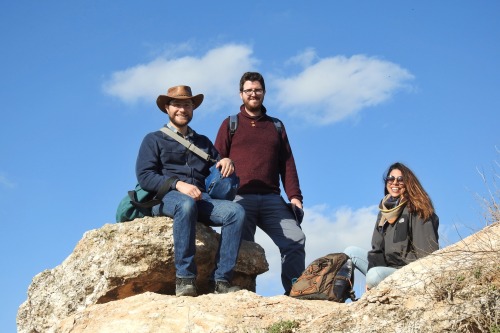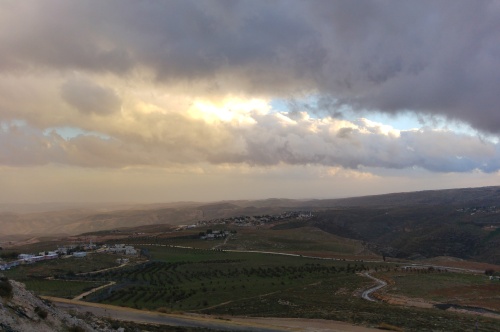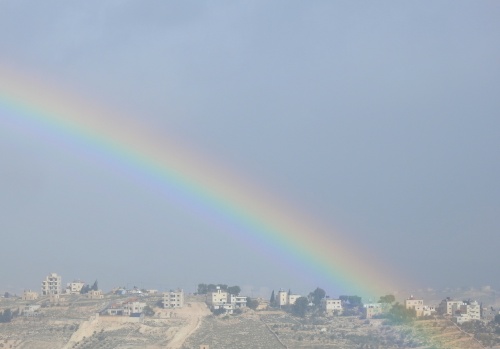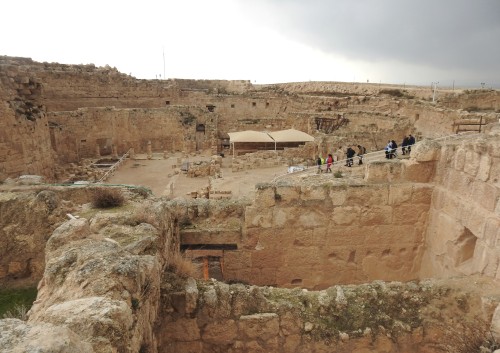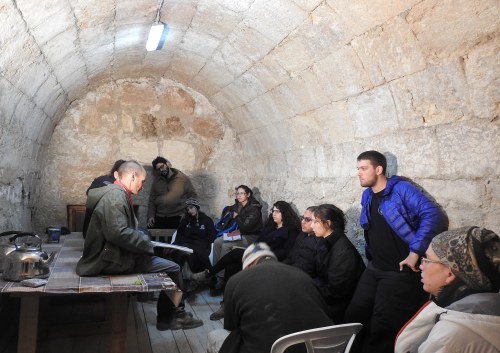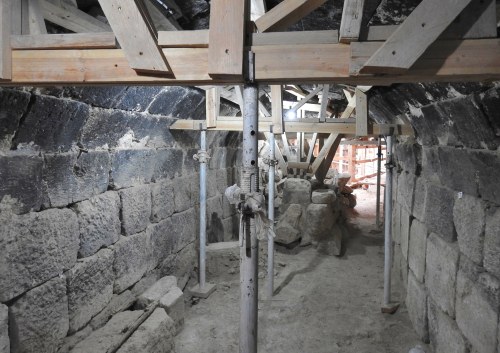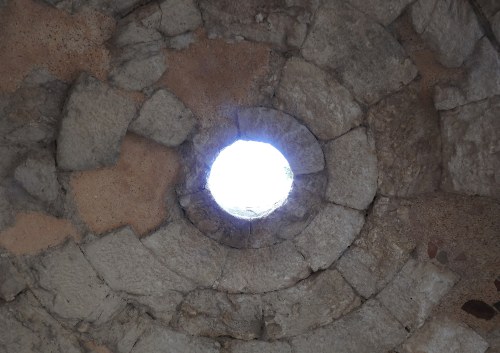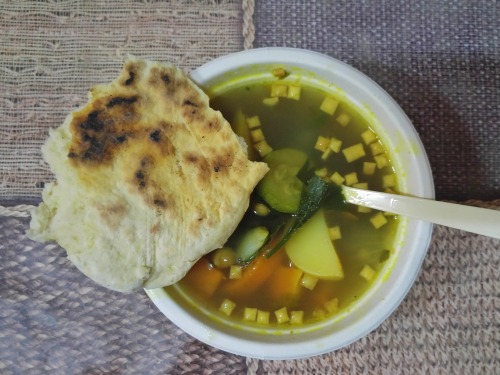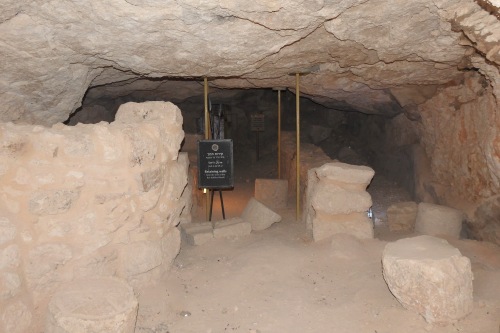This post harkens back to the late fall and winter months, when I participated in a series of archaeological explorations with Prof Boaz Zissu and other students. These explorations were part of my “Survey Basics” class with the Land of Israel Studies and Archaeology department at Bar Ilan University, taught by Prof Zissu (see also HERE). The first and third tours, having taken place back in October and December, were to Khirbet ‘Arak Hala. Located just north of Beit Guvrin, this site is largely comprised of a flattened enclosure, bathhouse and ancient settlement – all dated to the Roman period.
The second survey, back in November, was to Khirbet Amudim, located in an active military firing zone, in the Judean foothills. Our duty that day was primarily to locate and map out caves and underground expanses, and it was very rewarding with fascinating caves and many interesting species of wildlife, including horseshoe bats and hungry cave ticks.
However, this post is about the fourth survey day, to Herodium – or more precisely, to the hilltop adjacent to the mountain-top fortress. It was Dec 27th, and there was rain in the forecast for most of the country, but being that Herodium is located in the Judean Desert where rainfall is less common, it was decided that the survey day will continue as planned. Thus, our tour bus transported us first thing in the morning to Herodium where the rest of the team was waiting patiently.
The very first thing that we noticed was the biting cold wind which penetrated our clothing and chilled us to the bone. We found shelter within the visitors centre, and were briefed on the history and archaeology of Herodium by both Prof Zissu and the site’s resident archaeologist, Roi Porat.
Properly briefed, we then headed outside and made our way to the hilltop northeast of Herodium. It was chilly, with rain clouds in the distance, but a full rainbow appeared before us and life was looking great. We were divided into two teams, each tasked with scanning a particular area for potsherds and other archaeological evidences.
Within a half hour, as the teams were gathering the many scattered potsherds, a cold biting rain began. Blown by powerful gusts of mountain wind, the freezing rain made surveying quite difficult. We continued the best we could, but then, as we were finishing up, the rain intensified. We beat a hasty retreat to the visitors centre, but the downpour was quicker than we were and we returned soaking and cold.
After laying out some of our clothes to dry in a heated room, we gathered around to take stock of the potsherds we had found. The bags were spilled out and divided up, the indicative pieces (such as rims and handles) analysed and identified. We made an estimation of the typologies, factoring in the age of the sherds, and developed a rough picture of the site’s age. When we were finished, we had a debrief, and then ventured out into the park to explore Herodium’s ruins.
Herodium, the iconic mountaintop fortress, was constructed by Herod the Great before the turn of the millenium during the Roman period. The site is divided into three main areas: the fortress, the slopes and the lower region. The fortress was designed to have four towers, the eastern one being most prominent, and the interior of the palace complete with a courtyard nestled within. Towards the end of the construction, dirt was added to the outer walls of the round fortress, giving the appearance of a luxuriously-filled volcano. When Herod died, in the year 4 BCE, he was buried on the slopes of Herodium, in a monumental structure built in his honour.
Later, during the Jewish revolts against the Romans, Herodium was occupied by the rebels and refuge tunnels were dug beneath the fortress. After the final tunnels were burned out in battle, Herodium laid waste until Christian monasteries was built during the Byzantine times. From the Arab conquest onward, dating back some 1,400 years, Herodium laid in ruins with just a few local Bedouins keeping the site company. Following surveys starting in 1873, archaeological work began in 1962 and have been continuing on-and-off since then.
We climbed the hill via the footpath, and entered the fortress complex from the western side, passing various archaeological features and the view of Lower Herodium along the way. The palace remains came into sight as we crested the slope’s top, entering into the ancient courtyard. Raindrops had begun to fall, and we were ushered into the belly of the palace-fortress, entering chambers generally off-limits to the public until the restorative work in complete. Roi Porat led us down a perilous staircase, and into a quaint vaulted room where we set down our bags and got comfortable.
Some of the team joined the department’s patron, Yehuda Mizrahi, in preparing a hearty lunch while the rest of us gathered around to hear more about the ongoing excavations. After an overview, we set out to see the emptied storage rooms that once housed the Jewish rebels during the Roman era. Fallen stones, blackened ceilings and bone-dry logs illustrated the scene frozen in time, as the tunnels were set aflame to burn out the trapped Roman soldiers.
We spent a good half hour in the tunnel-like chambers, discussing archaeological technique and theories with Prof Zissu and Roi Porat. When we had had our fill, a concept that was hard to imagine, we headed back outside, via the vaulted room, for another gander now that the sun had come back out.
With so much to see, from the curved internal walls to the many columns and other architectural features, it’s hard to fully relate the true wonder of the site. I passed from the southern portico to the reception hall and ancient synagogue, and then from the weapons foundry and the Byzantine chapel to the bathhouse and northern exedra.
Throughout the fortress’ interior, signs delineated both the Herodian-era ruins and the later ruins, often times occupying the same space. I spent time in each spot, taking pictures and admiring the construction before moving on.
Minutes later, when I entered the underground tunnel system, I was truly blown away. The white tunnels, carved from the soft rock, seemed endless and I descended deeper and deeper into the mountain.
I passed water shafts and retaining walls, keeping to the main path as I pressed onward. Several of the side passages were fenced off, accessible only to the site excavators, but I was happy enough with the prepared tunnels. Deeper and deeper the tunnel went, until at last it leveled out and I found myself headed towards one of the exits not far from the elegant theatre and Herod’s tomb.
Breaking down the underground system, the cisterns date to the Herodian period, where as the tunnels date both to the Jewish War and the Bar Kochba Revolt several dozen years later. I emerged from the tunnel via a large room, and made my way around the slope ruins. Not wanting to miss lunch, I headed back into the bowels of the mountain and back up into the fortress courtyard to rejoin my group in the quaint vaulted room.
Everyone had reconvened from their exploration ventures and lunch was being served from the makeshift kitchen. We sat down to hot soup, freshly made pitas, breads, salads and preserved meat. It was a kingly feast, and we felt downright special eating it in the quaint stone room. As lunch winded down, we sat around about swapping amusing stories until it was time to clean up and head back out into the cold wind.
We exited via the tunnels and began to explore the slope ruins, but first, a Finsch’s wheatear popped into view and I snapped a handful of sub-par pictures before it flew off. Walking the slope path, we came upon the theatre which once hosted great entertainment during the Herodian period. Next, the two sets of ancient steps that head up the slope towards the peak, each built in a different time period.
From there we continued on to the area of the royal tomb, where Herod was buried. During the Jewish War, some of the Jewish population didn’t take too kindly to his burial place and proceeded to tear it down. Today, foundations, architectural elements and many of the ashlars have been found – signs of a monumental structure – but that’s about it. Citing physical and historical evidence, a miniature version of the ornate tomb was reconstructed, and provided us an idea of what the original structure looked like.
As we enjoyed the views from the slope, the rain and bitterly cold winds picked up again. The walk back to the visitors centre wasn’t necessarily far, but with the rain and cold it was quite the trek. I particularly enjoyed seeing the falling raindrops flying upwards at my face as the wind changed the standards of gravity. Eventually we made it back to the visitor centre and prepared ourselves to head back to Bar Ilan University.
This was the final survey day of the survey class, but due to the relative success of the adjacent hilltop’s surface find collection, another survey day was immediately scheduled. Unfortunately I was unable to attend the second day, but I heard that it was absolutely delightful. Having finished my survey requirements for my BA, I hope that maybe next year I’ll be able to take part in a survey as part of my MA – time will tell.

